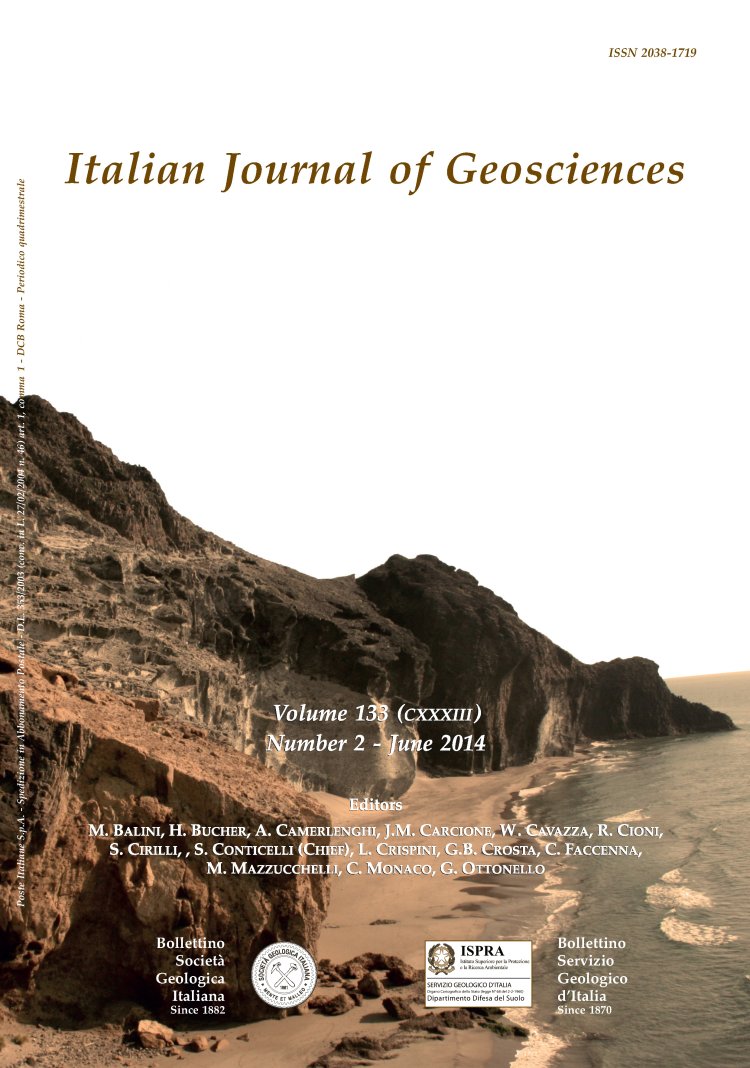
The significance of Longobucco Unit (Calabria-Peloritani Arc) in the evolution of the Ionian and Alpine Oceans
Leonsevero Passeri (*), Gloria Ciarapica (*), Letizia Reggiani (**) & David C. Rutledge (***)
(*) Strada Bardoney 10, 11021 Breuil-Cervinia (Aosta),
Italy. Corresponding author: Gloria Ciarapica, tel. 0166949365, cell. 3345034649, gloria.ciarapica@unipg.it
(**) 5 Ffordd Heulyn, Y Felinheli, Gwynedd, LL56 4 QT,
Wales, UK.
(***) PetroStrat Ltd, Tan-y-Graig, Parc Caer Seion, Conwy, LL32 8FA, Wales, United Kingdom.
Volume: 133 (2014) f.2
Pages: 249-270
Abstract
In the geological literature the Longobucco Unit, as well as the whole Calabria-Peloritani Arc (CPA), was interpreted in opposite ways: 1) as part of the African-Adria Plate (thus belonging to Austroalpine Units) previously involved in the eo-Alpine deformation with an european vergence and then thrust southeastwards on the Apennine chain; 2) as parts of the European continental margin involved only in the Apenninic orogeny; 3) as part of a microplate between two branches of the Alpine ocean (Pennidic O. and Ligurian O). In this paper we contribute to the solution of this controversial problem with basin analysis on the Longobucco Mesozoic cover, taking into account the paleogeographic evolution of the West Mediterranean area during the Mesozoic.
1) At first, the sedimentary successions of the Longobucco Unit (Early Jurassic-Miocene) are re-examined. The peculiar occurrence of conglomerates with pebbles of Variscan basement from the Early Jurassic, the existence of carbonate ramps attached to an exposed continental area in the Hettangian-Sinemurian and the huge amount of silici-clastic grains in the entire Mesozoic succession witness for the deposition on a continental margin exposed to either erosion and synsedimentary tectonics.
2) The coeval successions of the Apennines (Adria Plate), southern Sicily (African Plate) and eastern Sardinia (European Plate) are compared to understand which exposed areas had to be the source for the terrigenous sediments. Our conclusion supports the hypothesis (already formulated by various authors) that from the oceanic opening of the Alpine Ocean (Middle Jurassic) the Longobucco Unit and the whole CPA were part of the European Plate.
3) The comparison between the nappes stack of CPA and that well known in the Western Alps confirms the idea that the CPA cannot be considered as Austroalpine Unit. In fact, despite the same occurrence of granulitic facies, the differences are remarkable: different dip of subduction plane, different vergence, different age of HP/LT metamorphism, different age of exhumation and even different Mesozoic cover. Therefore CPA has to be considered as part of the European Plate.
4) The original position of CPA is very important to define the relationship between the Ionian and the Alpine Oceans in the western Mediterranean area. Here, the oceanic spreading of Ionian basin occurred in the Ladinian and, from the Late Eocene, this ocean was subducted northwards below the European and Adria Plates.
Oceanic spreading of the Alpine trough began in the Middle Jurassic and, from the Late Cretaceous, this ocean was subducted south and eastwards below the Adria Plate. The European origin of the CPA indicates a possible existence of direct communication between those two oceans. In our interpretation this connection was related to a sinistral trasform fault that crossed the western part of the modern Mediterranean area from the Late Triassic.
5) The presumed existence of a Jurassic microcontinent (AlKaPeCa) is critically discussed and it appears inconsistent with stratigraphic data. In conclusion, CPA (and the whole AlKaPeCa) cannot be considered as Austroalpine Units or a microcontinent, but as a marginal part the European plate involved in the north-dipping subduction of the Ionian Ocean. This subduction produced a southvergent stacking of the various Calabrian units and began around 43 Ma below the CPA, long before the involvement of the Corsica continental margin in the east-dipping subduction of the Alpine Ocean (34 Ma).
Keywords
Calabria-Peloritani Arc, Longobucco, Ionian Ocean, Alpine Ocean, Stratigraphy, edimentology, Paleogeography, Jurassic, Early Cretaceous.
Get Full Text